Integral Resistors in High Frequency Printed Wiring Boards
Bruce P. Mahler
Ohmega Technologies Inc.
Culver City, CA
The growing need to eliminate discrete resistors is driven by design trends toward faster speeds, shorter trace lengths and smaller boards with higher component densities. Printed wiring boards (PWB) have become complex packages hosting high density interconnections and new dielectric materials for proper system performance at faster operating frequencies. The complexity, sophistication and demands of electronic systems are forcing an integration of logic, circuit design and package design. Integral resistors in the form of planar resistor technology (PRT) in PWBs have become a tool for the circuit designer when addressing some of these packaging demands.
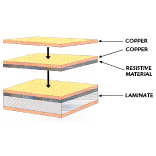 PRT is a thin-film metal alloy system that consists of an insulating substrate and a two-layer bifunctional cladding, as shown in Figure 1 . The lower layer that is located against the base laminate surface is an electrically resistive material; the upper layer is copper. The two layers of this bifunctional cladding are in contact with each other over their entire area. Using standard subtractive PWB print and etch techniques, layers are differentially defined so that separate patterns of conductors and resistors are formed, as shown in Figure 2 .
PRT is a thin-film metal alloy system that consists of an insulating substrate and a two-layer bifunctional cladding, as shown in Figure 1 . The lower layer that is located against the base laminate surface is an electrically resistive material; the upper layer is copper. The two layers of this bifunctional cladding are in contact with each other over their entire area. Using standard subtractive PWB print and etch techniques, layers are differentially defined so that separate patterns of conductors and resistors are formed, as shown in Figure 2 .
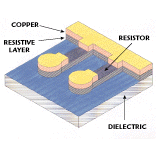 PRT has been used in multilayer PWBs for more than 25 years, primarily for terminating and pull-up/pull-down resistors.1 The technology has demonstrated excellent reliability in consumer electronics, computer systems, military and aerospace circuits, and telecommunication switching equipment. Some examples of these applications are shown in Figure 3 (termination resistors in a ball-grid array (BGA) package) and Figure 4 (termination and pull-up resistors in an asynchronous transfer mode (ATM) switching card). Most of these applications operate at relatively low frequencies (less than 1 GHz) and make use of traditional PWB dielectric materials such as epoxy-glass FR-4 and, for higher temperature applications, polyimide.2
PRT has been used in multilayer PWBs for more than 25 years, primarily for terminating and pull-up/pull-down resistors.1 The technology has demonstrated excellent reliability in consumer electronics, computer systems, military and aerospace circuits, and telecommunication switching equipment. Some examples of these applications are shown in Figure 3 (termination resistors in a ball-grid array (BGA) package) and Figure 4 (termination and pull-up resistors in an asynchronous transfer mode (ATM) switching card). Most of these applications operate at relatively low frequencies (less than 1 GHz) and make use of traditional PWB dielectric materials such as epoxy-glass FR-4 and, for higher temperature applications, polyimide.2
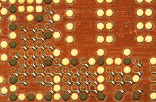 There has been a growing use of PRT in high frequency applications, primarily for transmission line terminations and attenuators. Integration of resistors into PWBs for high frequency use has some desirable benefits: greater packaging densities, elimination of the resistor assembly, weight savings, reduction of interconnection line lengths and a reduction in the parasitic inductances and capacitances associated with discrete chip resistors.3
There has been a growing use of PRT in high frequency applications, primarily for transmission line terminations and attenuators. Integration of resistors into PWBs for high frequency use has some desirable benefits: greater packaging densities, elimination of the resistor assembly, weight savings, reduction of interconnection line lengths and a reduction in the parasitic inductances and capacitances associated with discrete chip resistors.3
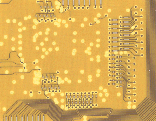 PRT has been successfully used in numerous microwave applications on a variety of polytetrafluoroethlylene (PTFE)-based dielectrics, including Duroid® 5880 and 6002, CLTE® and Speedboard.® Two application examples are Dassault Electronique’s active phased-array antennas (which use PRT on 60024 laminate material) and Loral Space’s Globalstar S-band and L-band antennas (which use PRT on CLTE with Speedboard bonding sheets), shown in Figures 5 and 6, respectively. Both applications use multilayer structures with the PRT resistors embedded within the circuit board.
PRT has been successfully used in numerous microwave applications on a variety of polytetrafluoroethlylene (PTFE)-based dielectrics, including Duroid® 5880 and 6002, CLTE® and Speedboard.® Two application examples are Dassault Electronique’s active phased-array antennas (which use PRT on 60024 laminate material) and Loral Space’s Globalstar S-band and L-band antennas (which use PRT on CLTE with Speedboard bonding sheets), shown in Figures 5 and 6, respectively. Both applications use multilayer structures with the PRT resistors embedded within the circuit board.
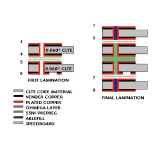 Introduction of newer dielectric materials for microwave applications has led to a corresponding interest for PRT on these new materials. One such application is a 16-way power divider, shown in Figures 7 and 8 , which is produced by Merrimac Industries and uses PRT on RO3003® dielectric. Merrimac has been successful with etching resistors as small as 0.015" x 0.015" using 25, 50 and 100 W/sq sheet resistivity PRT. Resistor tolerances have been maintained to ±10 percent for 25 and 50 W/sq material through the entire process, including fusion bonding. Resistor tolerances of ±20 percent have been maintained for 100 W/sq through all processes. The 16-way power divider is run four-up on a 9" x 12" array.
Introduction of newer dielectric materials for microwave applications has led to a corresponding interest for PRT on these new materials. One such application is a 16-way power divider, shown in Figures 7 and 8 , which is produced by Merrimac Industries and uses PRT on RO3003® dielectric. Merrimac has been successful with etching resistors as small as 0.015" x 0.015" using 25, 50 and 100 W/sq sheet resistivity PRT. Resistor tolerances have been maintained to ±10 percent for 25 and 50 W/sq material through the entire process, including fusion bonding. Resistor tolerances of ±20 percent have been maintained for 100 W/sq through all processes. The 16-way power divider is run four-up on a 9" x 12" array.
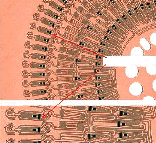 Merrimac’s success with ™ packaging technology. Multi-Mix technology enables filters, multiplexers, MMICs and other active and passive circuits to be packaged in a manner similar to application-specific ICs for RF/microwave applications.5
Merrimac’s success with ™ packaging technology. Multi-Mix technology enables filters, multiplexers, MMICs and other active and passive circuits to be packaged in a manner similar to application-specific ICs for RF/microwave applications.5
A joint effort by Ohmega Technologies Inc. and Rogers Corp. was begun to evaluate PRT on some of these new dielectric materials. RO3003, RO4003® and TMM3® dielectrics were tested along with an FR-4 control substrate. The RO3003 material is a nonwoven ceramic-filled PTFE composite, RO4003 is a woven-glass-reinforced ceramic-filled thermoset material and TMM3 is a ceramic thermoset polymer composite.
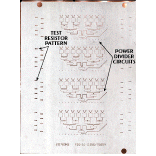 One of the main concerns of PRT on these materials was adhesion. The presence of the ceramic filler could significantly reduce the bond strength of the laminated product due to a reduction in the resin-to-filler ratio. A determination of the effects of bonding temperatures and pressures on the thin-film resistive material’s physical and electrical characteristics was required.
One of the main concerns of PRT on these materials was adhesion. The presence of the ceramic filler could significantly reduce the bond strength of the laminated product due to a reduction in the resin-to-filler ratio. A determination of the effects of bonding temperatures and pressures on the thin-film resistive material’s physical and electrical characteristics was required.
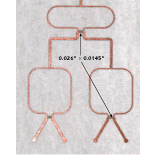 PRT of a variety of sheet resistivities (25, 50 and 100 W/sq) and two copper weights (1/2 and 1 oz) was bonded to 0.020"-thick substrates of RO3003 and RO4003 and 0.050"-thick TMM3. These laminated sheets were processed into two-resistor array patterns for testing. The first test pattern, shown in Figure 9 , was an array of 0.5"-sq resistors used to test the sheet resistivity of the PRT material. Large resistors were used to eliminate the effects of dimensional variations on the resistor due to the subtractive print and etch process. This test pattern also contained standard Institute for Packaging Electronic Circuits-specified peel coupons for bond strength testing. The second test pattern consisted of a series of 10 square resistors ranging in size from 1.0" x 0.1" to 0.125" x 0.0125", as shown in Figure 10 . This test pattern was used to evaluate the environmental and electrical characteristics of the PRT material. Preliminary results of this study are listed in Table 1 . Determination of the high frequency electrical characteristics of PRT on these dielectric materials is now underway by Rogers.
PRT of a variety of sheet resistivities (25, 50 and 100 W/sq) and two copper weights (1/2 and 1 oz) was bonded to 0.020"-thick substrates of RO3003 and RO4003 and 0.050"-thick TMM3. These laminated sheets were processed into two-resistor array patterns for testing. The first test pattern, shown in Figure 9 , was an array of 0.5"-sq resistors used to test the sheet resistivity of the PRT material. Large resistors were used to eliminate the effects of dimensional variations on the resistor due to the subtractive print and etch process. This test pattern also contained standard Institute for Packaging Electronic Circuits-specified peel coupons for bond strength testing. The second test pattern consisted of a series of 10 square resistors ranging in size from 1.0" x 0.1" to 0.125" x 0.0125", as shown in Figure 10 . This test pattern was used to evaluate the environmental and electrical characteristics of the PRT material. Preliminary results of this study are listed in Table 1 . Determination of the high frequency electrical characteristics of PRT on these dielectric materials is now underway by Rogers.
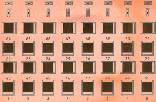 The RO3003 sheet resistivity test data were consistent with high temperature bond effects. The RO3003 dielectric (a PTFE material) is bonded at temperatures in excess of 700°F. The 25, 50 and 100 W materials showed shifts of about eight, 18 and 43 percent, respectively. The higher shift in the 100 W material is likely due to a combination of the high temperature bonding and dielectric stress of the soft RO3003 material on the thin PRT.
The RO3003 sheet resistivity test data were consistent with high temperature bond effects. The RO3003 dielectric (a PTFE material) is bonded at temperatures in excess of 700°F. The 25, 50 and 100 W materials showed shifts of about eight, 18 and 43 percent, respectively. The higher shift in the 100 W material is likely due to a combination of the high temperature bonding and dielectric stress of the soft RO3003 material on the thin PRT.
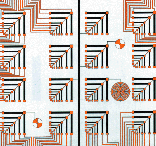 The RO4003 material is bonded at temperatures in excess of 450°F. The resultant ohmic value shift is somewhat less than that caused by the 700°F+ temperatures of PTFE lamination. The 25 W material showed a shift of approximately seven percent, the 50 W material a shift of 15 percent and the 100 W material a shift of 21 percent. The significantly better results in 100 W material are likely due to less dielectric stress in the harder RO4004 product.
The RO4003 material is bonded at temperatures in excess of 450°F. The resultant ohmic value shift is somewhat less than that caused by the 700°F+ temperatures of PTFE lamination. The 25 W material showed a shift of approximately seven percent, the 50 W material a shift of 15 percent and the 100 W material a shift of 21 percent. The significantly better results in 100 W material are likely due to less dielectric stress in the harder RO4004 product.
The TMM3 results show very little sheet resistivity shift compared to FR4 data. The bonding temperature is also in excess of 450°F but at a significantly reduced press time (less than half that of the RO4003 material). The 25 W material showed a shift of approximately three percent, the 50 W material a shift of five percent and the 100 W material a shift of seven percent.
|
Table 1 | |||
|
Resistivity |
Copper |
Measured |
Standard Deviation |
|
FR-4 (Control) | |||
|
25 |
1/2 |
25.0 |
0.3 |
|
25 |
1 |
24.2 |
0.4 |
|
50 |
1/2 |
50.7 |
1.8 |
|
50 |
1 |
51.0 |
1.5 |
|
100 |
1/2 |
96.0 |
2.5 |
|
100 |
1 |
97.6 |
3.1 |
|
RO3003 | |||
|
25 |
1/2 |
27.14 |
0.28 |
|
25 |
1 |
25.88 |
0.28 |
|
50 |
1/2 |
59.14 |
1.13 |
|
50 |
1 |
60.92 |
1.12 |
|
100 |
1/2 |
140.57 |
3.57 |
|
100 |
1 |
137.25 |
3.68 |
|
RO4003 | |||
|
25 |
1/2 |
26.92 |
0.49 |
|
25 |
1 |
25.52 |
0.46 |
|
50 |
1/2 |
58.96 |
0.99 |
|
50 |
1 |
58.47 |
0.71 |
|
100 |
1/2 |
118.24 |
3.17 |
|
100 |
1 |
115.30 |
2.67 |
|
TMM3 | |||
|
25 |
1/2 |
25.8 |
0.14 |
|
25 |
1 |
25.01 |
0.29 |
|
50 |
1/2 |
53.71 |
0.51 |
|
50 |
1 |
52.67 |
0.53 |
|
100 |
1/2 |
104.7 |
1.17 |
|
100 |
1 |
102.58 |
1.99 |
Tables 2 , 3 and 4 list the results of peel strength, solder float and thermal coefficient of resistivity (TCR) evaluations, respectively. The peel PRT on RO3003 was excellent. These data are similar to results on RO6002 and CLTE substrate materials. The RO4004 dielectric showed a lower bond than the FR4 control sample for all sheet resistivities with a fairly consistent reduction of two pounds per inch.
|
Table 2 | ||
|
Resistivity |
Copper |
Peel Strength |
|
FR-4 (Control) | ||
|
25 |
1/2 |
4.5 |
|
25 |
1 |
6.0 |
|
50 |
1/2 |
5.0 |
|
50 |
1 |
7.2 |
|
100 |
1/2 |
5.1 |
|
100 |
1 |
7.3 |
|
RO3003 | ||
|
25 |
1/2 |
14.0 |
|
25 |
1 |
14.2 |
|
50 |
1/2 |
13.6 |
|
50 |
1 |
14.2 |
|
100 |
1/2 |
13.8 |
|
100 |
1 |
13.8 |
|
RO4003 | ||
|
25 |
1/2 |
2.8 |
|
25 |
1 |
4.0 |
|
50 |
1/2 |
3.4 |
|
50 |
1 |
5.6 |
|
100 |
1/2 |
3.2 |
|
100 |
1 |
5.6 |
|
TMM3 | ||
|
25 |
1/2 |
0.8 |
|
25 |
1 |
0.4 |
|
50 |
1/2 |
1.6 |
|
50 |
1 |
2.8 |
|
100 |
1/2 |
1.2 |
|
100 |
1 |
2.6 |
The TMM3 dielectric had extremely low bonds. However, the etched resistors and copper traces had excellent line definitions, exhibiting no signs of flaking or material removal during the photofabrication process. A tape pull test was performed on all sheet resistivities. In this test, transparent tape with a typical bond strength of 2 lb/in is taped to the resistive material and removed. Normally, a resistive material with a bond strength of less than two pounds to the dielectric will be removed with the tape. In all cases on the TMM3 there was no resistive material removal with the tape. More bond strength testing of the TMM3 is being conducted to verify the original numbers.
|
Table 3 | ||
|
Resistivity |
Copper |
Solder Float |
|
FR-4 (Control) | ||
|
25 |
1/2 |
0.2 |
|
25 |
1 |
0.2 |
|
50 |
1/2 |
0.1 |
|
50 |
1 |
0.2 |
|
100 |
1/2 |
0.3 |
|
100 |
1 |
0.2 |
|
RO3003 | ||
|
25 |
1/2 |
-0.5 |
|
25 |
1 |
0.2 |
|
50 |
1/2 |
-0.1 |
|
50 |
1 |
-0.1 |
|
100 |
1/2 |
-0.2 |
|
100 |
1 |
-0.6 |
|
RO4003 | ||
|
25 |
1/2 |
-0.5 |
|
25 |
1 |
0.5 |
|
50 |
1/2 |
0.3 |
|
50 |
1 |
-0.5 |
|
100 |
1/2 |
0.3 |
|
100 |
1 |
0.5 |
|
TMM3 | ||
|
25 |
1/2 |
0.4 |
|
25 |
1 |
0.3 |
|
50 |
1/2 |
0.3 |
|
50 |
1 |
0.3 |
|
100 |
1/2 |
0.5 |
|
100 |
1 |
0.1 |
The solder float data for all resistivities and dielectrics show excellent stability in the PRT material. The TCR test was repeated to verify the data and yielded the same results. Typical TCR data for RO6002, RO5880 and CLTE are approximately 400 to 600 ppm/°C. The high bond temperature and extended bond cycle of PTFE materials raises the TCR of the PRT (compared to FR4 substrates). The RO3003 TCR data were substantially less than those of other PTFE materials. This result might be due to the shorter bond cycle compared to other PTFE materials. The RO4003 results were consistent with other thermoset materials with little difference in TCRs for the various sheet resistivities. The TMM3 data were by far the best. There was virtually no change in resistance with a change in temperature. The dimensional stability of TMM3 and the corresponding lack of temperature-induced stress in the dielectric material are the most likely reasons for this result.
|
Table 4 | ||
|
Resistivity |
Copper |
TCR |
|
FR-4 (Control) | ||
|
25 |
1/2 |
-15.0 |
|
25 |
1 |
-18.0 |
|
50 |
1/2 |
30.0 |
|
50 |
1 |
38.0 |
|
100 |
1/2 |
46.0 |
|
100 |
1 |
45.0 |
|
RO3003 | ||
|
25 |
1/2 |
73.5 |
|
25 |
1 |
80.3 |
|
50 |
1/2 |
44.9 |
|
50 |
1 |
56.1 |
|
100 |
1/2 |
36.7 |
|
100 |
1 |
42.3 |
|
RO4003 | ||
|
25 |
1/2 |
24.4 |
|
25 |
1 |
44.9 |
|
50 |
1/2 |
38.3 |
|
50 |
1 |
42.4 |
|
100 |
1/2 |
30.8 |
|
100 |
1 |
36.6 |
|
TMM3 | ||
|
25 |
1/2 |
-3.4 |
|
25 |
1 |
-2.2 |
|
50 |
1/2 |
-3.5 |
|
50 |
1 |
-5.2 |
|
100 |
1/2 |
-4.8 |
|
100 |
1 |
-6.1 |
Power testing was performed on 10 square resistors (0.05" x 0.5") of 25, 50 and 100 W/sq sheet resistivities on the surface of the test panel. All copper was 1 oz. Each resistor had continuous power applied to it at an ambient temperature of 25°C for two minutes after which time the resistor was cooled to room temperature and remeasured for ohmic value. The power was then increased and applied to the resistor for another two minutes and the resistor was once again tested. This procedure was repeated until the resistor exhibited a change in resistance value and became unstable. Table 5 lists the power load test results.
|
Table 5 | |||
|
RCM |
Reverse Clad |
Max Power |
Max Power |
|
RO3003 | |||
|
1R25/1 |
yes |
4.93 |
219.2 |
|
1A50/1 |
yes |
3.06 |
122.3 |
|
1A100/1 |
yes |
1.23 |
49.3 |
|
RO4003 | |||
|
1R25/1 |
yes |
5.46 |
218.6 |
|
1A50/1 |
yes |
3.95 |
158.0 |
|
1A100/1 |
yes |
3.43 |
137.4 |
|
TMM3 | |||
|
1R25/1 |
yes |
4.27 |
170.8 |
|
1A50/1 |
yes |
3.67 |
146.8 |
|
1A100/1 |
yes |
2.77 |
110.9 |
Typical power rating for PRT bonded to FR4 material (Tg = 140°C) is approximately 125 W/in2 of resistive material for 25 W/sq product, 100 W/in2 for 50 W/sq product and 75 W/in2 for 100 W/sq product. All data, with the exception of the 100 W/sq material on the RO3003, exhibited a significantly better power rating than PRT on FR4. This result is due to the high temperature characteristic of the dielectric materials. The RO3003 100 W data might be inaccurate due to handling damage of the tested resistors causing instability in values unrelated to the power test. A repeat of this test is currently underway.
Conclusion
Integral resistor use in high frequency applications is growing rapidly. New dielectric materials are being introduced to address both the processing and electrical requirements of these new applications. The benefits of PRT make it an important part of many of these applications. Preliminary characterization testing of PRT on RO3003, RO4003 and TMM3 material has been completed. The data are encouraging with more test results expected soon.
Acknowledgment
This article is based on material first presented at the 1999 Wireless Workshop. Figures 5, 6 and 7 are courtesy of Tyco-Stafford Printed Circuit Group Inc.; Figures 8 and 9 are courtesy of Merrimac Industries, West Caldwell, NJ. Duroid is a registered trademark of Roger Corp., Chandler, AZ. Multi-Mix is a trademark of Merrimac Industries, CLTE is a registered trademark of Arlon, Bear, DE. Speedboard is a registered trademark of W.L. Gore, Eau Claire, WI.
References
1. Scott Fillebrown and Bruce Mahler, “Board-embedded Planar Resistors for High-density Circuits,” US Tech , January 1997.
2. Paul Schroeder, and Bruce Mahler, “Planar Resistor Technology for High-speed Multilayer Board,” Electronic Packaging & Production , January 1986.
3. Joris Peeters et al., “Characterization of Integrated Resistors for Broadband Telecom Printed Circuit Boards,” IPC World Expo Proceedings , 1996.
4. Bernard Ledain and Jean Herblot, “Innovative Multilayer Technologies for Active Phase Array Antennas,” report from Dassault Electronique, Saint-Cloud, France.
5. Merrimac Industries Inc., “A Three-channel Vector Modulator with Reference Channel,” Microwave Journal , Vol. 41, No. 11, November 1998, pp. 128-134.
Bruce P. Mahler received his BS from California State University. He has more than 25 years of experience in the electronic packaging industry and is currently VP, sales and technical marketing at Ohmega Technologies. Mahler has three patents and has published numerous articles on a variety of electronic packaging technologies.
